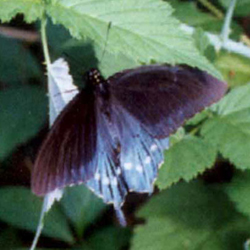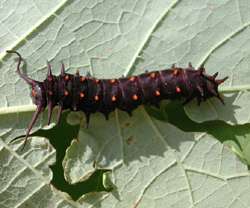Find a Butterfly
Pipevine Swallowtail
Battus philenor
Named
Linnaeus, 1771

Identification
Wingspan: 2 3/4 ‑ 3 3/8". The Pipevine Swallowtail superficially resembles a number of large northeastern butterflies (see notes), but may be told by the following characteristics: Forewings above black and unspotted; hindwings iridescent blue‑green (brighter in the male) above, with submarginal row of cream‑colored spots; hindwings beneath with iridescent blue patch crossed by a single curving row of large, black‑bordered orange spots. (Black and Spicebush Swallowtails have a double row).
Distribution
Pipevine Swallowtails range east and south of a line drawn from the Great Lakes to southern California, with an isolated population in north‑central California. South of the United States, the species is found into northern Central America. In New England, it occurs in southern portions, rarely north of Massachusetts.
Status in Massachusetts
This species has historically been, and continues to be, erratic in its distribution. During the latter part of the nineteenth century, according to Scudder, Pipevine Swallowtails were always excessively scarce in Massachusetts. In the early twentieth century, many populations were noted in the Boston area, the species apparently common in restricted locales some years. Occasionally the larvae were present in large numbers, sufficient to "seriously defoliate plants" (Farquhar, 1934). During the Atlas period, there were fifteen records, with fourteen from 1986‑1988. The species was widely distributed, though unrecorded from northernmost Massachusetts and Cape Cod, Martha‘s Vineyard, and Nantucket. Still, it did a bit of island‑hopping, and we have Atlas records from Penikese Island in Buzzard‘s Bay and Thompson‘s Island in Boston Harbor. Recent maximum: one.

Flight Period in Massachusetts
Observed from early June to early October, with a concentration of sightings in late July/early August. The actual flight period may extend about two weeks on either side of our extreme dates: 1 June 1986, Middleboro (Plymouth Co.), K. S. Anderson and 5 October 1986, Florence (Hampshire Co.), T. Gagnon.
Larval Food Plants
Throughout its range, the Pipevine Swallowtail feeds on various species of Aristolochia vines. The Dutchman‘s Pipe (Aristolochia durior), which occurs natively as far north as Pennsylvania and in cultivation (with local escapees) well into New England, is the local food source. Spread of cultivated pipe vines has extended the species‘ range substantially.
Adult Food sources
Various wild and garden flowers, including milkweeds, orchids, azaleas, thistles, and phlox are visited avidly. Pink and purplish blossoms are preferred.

Habitat
In Massachusetts, the Pipevine Swallowtail is most often found in rather open situations: at a woodland edge, in a garden, or among the flowers of a shrub thicket. Further south, it is "most abundant in deciduous forests of the Appalachians" (Opler and Krizek, 1984), though it occurs in a variety of habitats.
Life Cycle
EGG: Reddish‑brown; dome‑shaped. OVIPOSITION: Eggs laid in clusters of up to 20, on leaves and stems. LARVA: Black or dark reddish‑brown, with reddish tubercles and black protruding filaments. CHRYSALIS: Reddish‑brown or green, with yellowish blotches.
Notes
In Massachusetts, at the northern periphery of this species‘ range, we have seen no evidence of breeding by the Pipevine Swallowtail for at least the past decade. Larvae are strikingly marked and feed gregariously when young and should be looked for on ornamental pipevines in our area. Adults fly with a distinctive, low‑amplitude wingbeat. Freshly emerged males are attracted to mud puddles in large concentrations in the South.
Pipevine Swallowtails are unpalatable and serve as models in a Batesian mimicry complex that includes six mimics: Red‑spotted Purple, Spicebush Swallowtail, and females of the following species: Black Swallowtail; Tiger Swallowtail (dark form); Missouri Woodland Swallowtail; and the Diana (Note: the first three species occur in Massachusetts; the fourth, the dark female Tiger Swallowtail morph, flies as far north as Connecticut). These species mimic both the model‘s coloration and (excepting the Diana) its distinctive fluttering wingbeat and are avoided by avian predators, which confuse them with the Pipevine Swallowtail. Highest densities of the mimics occur south of New England, where the Pipevine Swallowtail is most abundant.
Account Author
Brian Cassie



